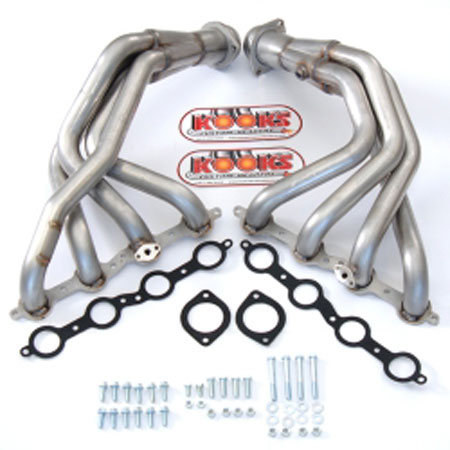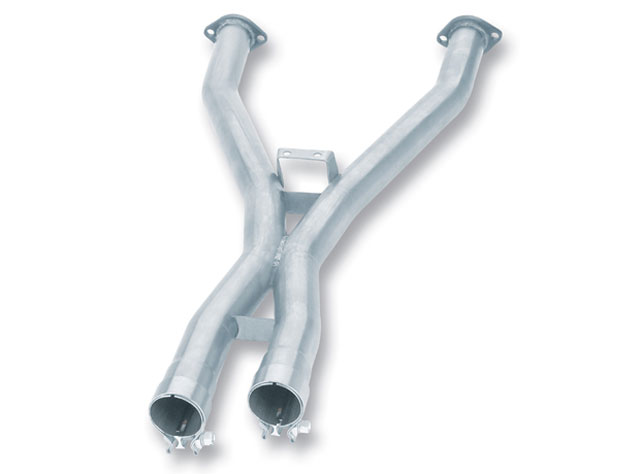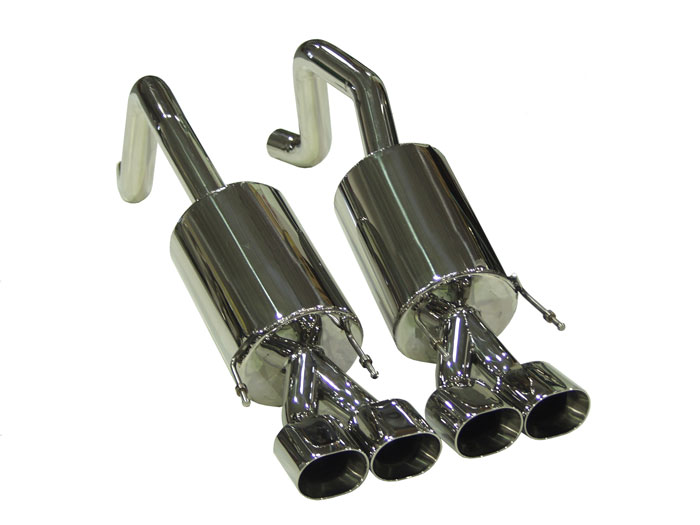
Corvette owners are fortunate to have plentiful options when it comes to choosing an exhaust system. From headers to mufflers, you can be confident that your goals of optimal performance or mesmerizing sound can be reached. Our product assistance reps field many questions on the exhaust systems we sell. Based on these questions, we’ve compiled some information to help you in your decision process.
Headers
Size. Most of Corvette Central’s customers have Corvettes that are intended for street driving. With this in mind, some think that large-diameter headers on a street car will reap big horsepower gains. Our advice is to resist that urge and stick with smaller diameter primary tubes (i.e. the 4 tubes that are closest to the cylinder head). As most street driving occurs in the lower RPM range, you will have more low and mid range torque to play with on conventionally sized headers (around 1 1/2″ to 1 5/8″ for small block 350’s). In any scenario, replacing factory cast-iron manifolds with headers will make the engine more efficient, as exhaust will scavenge quicker, making power and eliminating heat buildup.
Short tube vs. long tube. Compared with exhaust manifolds and headers, the difference between long-tube and short-tube headers is not as profound. Longer tube headers will make slightly more power. Short tube headers (shorties) are more suitable when under hood space is at a premium. Block hugger headers are a popular choice when clearance becomes an issue.
Coating. Adding a heat-resistant coating to headers is a great way to reduce engine bay temperatures. By forcing exhaust gases to the crossover pipe and beyond, coatings will preserve other components in the process. Under hood turbochargers also generate tremendous heat on their own, so coating headers will help control engine temperatures in these applications. A side benefit is improved looks. Spray painting headers with a heat resistant paint is one option, but for Corvette applications we hear of ceramic coatings more often. Another option is to purchase headers that are already coated from the manufacturer, or buying normal headers and sending them out to be coated.
A word of caution is to avoid using a heat-barrier wrap on street driven Corvettes. Although header wraps do an excellent job at containing exhaust heat, they are meant to be unwrapped and rewrapped with engine tear downs. In a street car, infrequent changing of wraps will lead to corrosion, as rainwater and other moisture will eventually get underneath the fabric. While these heat-barrier fabric wraps are excellent at containing heat and protecting surrounding surfaces, moisture can be trapped between the wrap and the tubes, and can lead to long-term rust or corrosion.

H-pipes vs X-pipes
An H-pipe is two pipes connected at the midsection by a perpendicular pipe, whereas an X-pipe criss-crosses between the two exhaust banks. Either setup should provide gains in low- and mid-range torque over independent dual exhaust pipes. Either setup should provide a deeper exhaust note, but as for selection, it boils down to personal preference. The H-pipe emits a sound that many would equate with pushrod V8’s, while the X-pipe may provide more of an exotic sound at different RPM’s. X-pipes should provide smoother exhaust transition between the two exhaust banks and may provide a smoother sound pitch. On street cars, if you decide to tie the two banks together in an effort to balance the exhaust pulses, either design is acceptable.
Virtually all V8 exhaust systems will benefit from the addition of an H- or X-pipe. These have two potential attributes: increased power and reduced noise. The noise reductions range from a minimum of 1 dB to a maximum of 3 dB. With engines between about 325 to 550 hp, most engines will realize as much as 12 additional hp with an H- or X-pipe, with 5-8 being the most common. Other engines showed virtually no change in output. In short, an H- or X-pipe is always a positive asset and never a negative.
The length of the crossover pipe does not affect performance, but the diameter does. An area at least equal to that of a 2.25-inch diameter pipe (4 square inches) with 2.5 to 2.75 inches is optimal. There seems to be no measurable benefit to using a crossover pipe larger than 2.75 inches in diameter.

Muffler Flow — How Much is Needed?
Reducing muffler restriction will increase potential engine power, but only to a limit. Once all the potential power is realized, further increases in exhaust system flow will not produce any further benefits in terms of power. Further increases in flow may also increase noise levels. In short, there is no real benefit to excessive muffler flow. The objective is to use just the right amount of muffler, no more and no less. This allows the full power potential of the engine to be realized without the side effect of excessive noise. So how much flow should you target?
An easy way to calculate muffler size in the standard measurement of cubic feet per minute (cfm) is to use the crank horsepower rating and multiply by 2.2. As an example, a V8 making 500 horsepower on open exhaust will require 500 x 2.2 = 1100 cfm. Two 550-cfm mufflers will limit the backpressure-induced power loss to 5 HP or less. As all mufflers are related in cfm, this makes choosing the right size simple.
By using no more muffler flow than needed we are giving whatever mufflers are selected the best chance of doing the job. Unfortunately, mufflers can be a little inconsistent and unpredictable in terms of noise suppression from one engine type to another. Situations involving high compression ratios and long-period cams are usually more demanding in terms of noise reduction. Big cubic inches, shorter cams, and lower compression ratios are easier to muffle. The biggest problem in this area is knowing whether or not a possible combination is quiet enough.
Exhaust pipes
There is no question that big diameter tail pipes look powerful, but again there is an issue of exhaust scavenging efficiency. Go too large and you may slow the scavenge rate, losing power in the process. If you must have the big pipe look, there are countless exhaust tips available to provide the big pipe appearance without sacrificing efficiency.
Exhaust turndowns, or “dumps”, are cost effective to be sure, but the trade off is in sound levels. With turndowns that exit before the rear bumper, the bodywork will act as a sound box in much the same way as a guitar body. The best solutions are to have them go all the way to the rear, with down turned exit pipes angled slightly in towards each other, or have side exits aimed 45 degrees to the ground.
Tail pipe length after the mufflers has no measurable effect on horsepower levels if you are utilizing an H- or X-pipe.
Have been a factory mechanic for 55 years, and you are wright. Sound versus performance. If your younger you will love all the noise. Older you are the more you want to hear what your thinking. I was pulled over for noise and when the police saw that i was a old fart , he let me go. Old farts with loud cars scores a win.